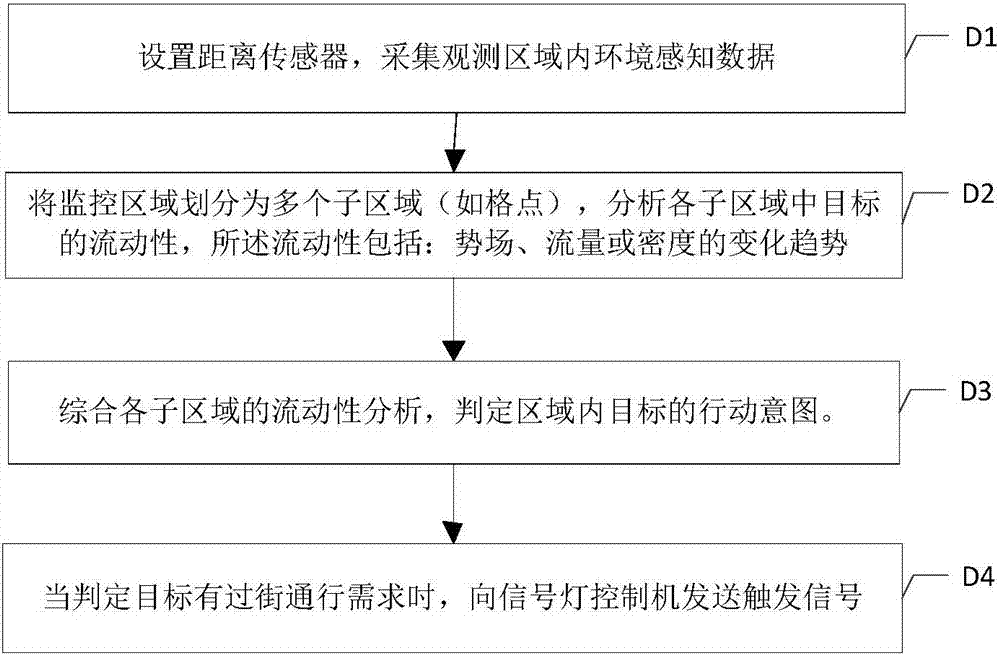Pedestrian intension detection method and system
A detection method and detection system technology, applied in the field of target tracking and target behavior analysis, can solve the problems of waste of road resources, pedestrian inconvenience, unreasonable utilization of road resources, etc., and achieve the effect of improving traffic efficiency
- Summary
- Abstract
- Description
- Claims
- Application Information
AI Technical Summary
Problems solved by technology
Method used
Image
Examples
no. 1 approach
[0023] like figure 1 Shown, the principle of an embodiment of the present invention is:
[0024] In D1, a distance sensor is set to collect environmental perception data (that is, distance data) in the observation area.
[0025] In D2, the monitoring area is divided into multiple sub-areas (such as grid points), and the fluidity of the target in each sub-area is analyzed. The fluidity includes: the change trend of the target potential field (or flow, density).
[0026] More specifically, step D2 includes:
[0027] D2-1. Based on the point cloud data collected on the sub-region (such as the grid point), calculate the potential field of the sub-region (such as the grid point), such as the density map and the posterior probability distribution.
[0028] A common method is, similar to the Mean-shift method, using a kernel function to calculate (see Comaniciu, D., & Meer, P. (1999), Distribution free decomposition of multivariatedata. Pattern analysis & applications, 2(1), 22 -3...
no. 2 approach
[0047] like figure 2 As shown, the second embodiment of the present invention is an improvement on the first embodiment.
[0048] In D1, a plurality of distance sensors are deployed at the intersection where the signal lights are located to collect environmental perception data (ie distance data) in the observation area. This is the same as the first embodiment.
[0049] The distance sensor can perform line scan, multi-line scan and / or area scan. It is generally recommended to use a single-line scanning laser distance sensor, and a multi-line scanning distance sensor or an area scanning distance sensor can also be used. The distance sensor is arranged at a fixed position, and the scanning plane of the distance sensor is parallel to the ground. Generally, the distance sensor is set at a height of 20-80 cm from the ground, so as to be able to scan the area of the legs and feet of pedestrians and the tire area of bicycles and electric vehicles.
[0050] The distance sens...
no. 3 approach
[0080] According to another aspect of the present invention, an intelligent pedestrian recognition system is proposed, including: one or more distance sensors, arranged at intersections where signal lights are located, for collecting target shape data.
[0081] The system of the present invention also includes a processor.
[0082] The processor can be configured to execute the steps described in the first embodiment.
[0083] According to another aspect of the present invention, a computer-readable carrier is proposed, the carrier records a computer-based operating program, and when the program is executed, the steps described in the first embodiment can be realized.
[0084] The intelligent pedestrian identification method and system of the present invention can intelligently identify pedestrians and vehicles. In addition to being applied to the control of traffic lights, it can also be applied to the following scenarios:
[0085] 1. Perimeter intrusion warning for schools,...
PUM
 Login to View More
Login to View More Abstract
Description
Claims
Application Information
 Login to View More
Login to View More - R&D
- Intellectual Property
- Life Sciences
- Materials
- Tech Scout
- Unparalleled Data Quality
- Higher Quality Content
- 60% Fewer Hallucinations
Browse by: Latest US Patents, China's latest patents, Technical Efficacy Thesaurus, Application Domain, Technology Topic, Popular Technical Reports.
© 2025 PatSnap. All rights reserved.Legal|Privacy policy|Modern Slavery Act Transparency Statement|Sitemap|About US| Contact US: help@patsnap.com



